Why this resume works
- Quantifies accomplishments: Highlighting measurable accomplishments, such as optimizing maintenance by 20% and cutting parts costs by $30,000 annually, reflects the applicant’s significant impact and value.
- Uses action-oriented language: Using action verbs like “optimized,” “reduced,” and “streamlined” showcases the applicant’s initiative and effectiveness.
- Showcases career progression: The progression from aircraft systems technician to aircraft mechanic shows a clear trajectory of increasing responsibility, reflecting career growth and expertise development.
More Aircraft Mechanic Resume Examples
Check out our aircraft mechanic resume examples to see how to showcase your technical skills, maintenance experience, and attention to detail. These aviation resume samples will help you create a resume that stands out to potential employers and wins interviews.
Entry-Level Aircraft Mechanic
Why this resume works
- Centers on academic background: The applicant’s education section features a master’s in aviation maintenance and a bachelor’s in mechanical engineering, showing a strong foundation pivotal for early career success.
- Effective use of keywords: Skillfully incorporating keywords like “safety compliance” and “technical precision,” the applicant ensures their resume aligns with industry standards.
- Shows digital literacy: Using advanced diagnostic tools reveals the applicant’s computer skills, showcasing their digital readiness for modern aviation roles.
Mid-Level Aircraft Mechanic
Why this resume works
- Points to measurable outcomes: Reducing safety incidents by 45% and cutting repair costs by $50,000 annually show how the applicant’s actions consistently lead to measurable improvements in aviation operations.
- Demonstrates language abilities: Language skills in Spanish, German, and French aid smooth communication in diverse aviation contexts.
- Includes a mix of soft and hard skills: Balancing technical diagnostics expertise with interpersonal skills like team leadership illustrates a well-rounded approach to improving workflow and maintaining aircraft performance.
Experienced Aircraft Mechanic
Why this resume works
- Showcases impressive accomplishments: By emphasizing achievements like leading a project that reduced downtime by 40%, the applicant showcases significant business impact.
- Focuses on work history: Using a chronological resume format, the applicant effectively outlines extensive career experience, highlighting a steady progression in aviation maintenance roles.
- Sections are well-organized: The applicant’s use of bullet points and clear headers ensures sections are well-organized, making the resume easy for readers to quickly scan and understand.
Aircraft Mechanic Resume Template (Text Version)
Jane Jones
Tacoma, WA 98411
(555)555-5555
Jane.Jones@example.com
Professional Summary
Experienced Aircraft Mechanic who optimizes efficiency. Proven record in maintenance improvement and safety compliance. Strong expertise in team leadership and diagnostics.
Work History
Aircraft Mechanic
SkyTech Aviation Services – Tacoma, WA
January 2023 – June 2025
- Optimized maintenance by 20% efficiency
- Reduced parts costs by ,000 annually
- Trained team, improving repair accuracy 15%
Aerospace Maintenance Technician
Northwest Aircraft Maintenance Corp – Spokane, WA
January 2021 – December 2022
- Streamlined inspections cut downtime 25%
- Saved ,000 by repairing parts in-house
- Enhanced safety protocols improving by 30%
Aircraft Systems Technician
JetLine Aviation Support – Tacoma, WA
June 2020 – December 2020
- Increased system check speed by 40%
- Reduced error rates by 15% through audits
- Boosted team efficiency with new tools
Skills
- Aircraft Maintenance
- Systems Diagnostics
- Safety Compliance
- Team Leadership
- Troubleshooting
- Technical Reporting
- Parts Procurement
- Preventive Maintenance
Education
Master of Science Aerospace Engineering
University of Washington Seattle, Washington
June 2019
Bachelor of Science Mechanical Engineering
California State University Long Beach, California
June 2017
Certifications
- Certified Aviation Technician – Federal Aviation Administration
- Advanced Aircraft Systems – AeroTech Institute
Languages
- Spanish – Beginner (A1)
- German – Intermediate (B1)
- French – Beginner (A1)
Related Resume Guides
Advice for Writing Your Aircraft Mechanic Resume
Explore our tips on how to write a resume for an aircraft mechanic position and discover how to highlight your technical skills and passion for aviation. Whether you’re tuning up jet engines or addressing hydraulic issues, showcasing your expertise is key.
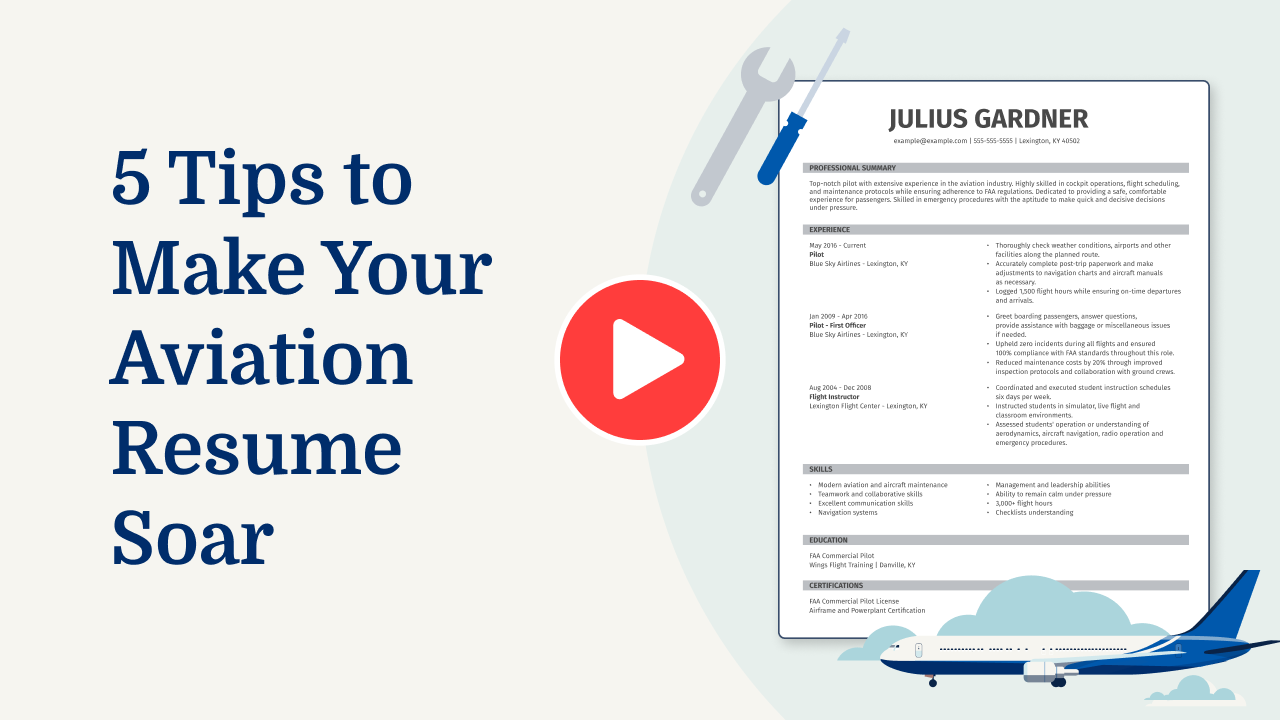
Highlight relevant technical skills
Having strong technical skills is key for an aircraft mechanic. These skills allow you to fix and maintain planes safely. It’s a good idea to make a skills section on your resume where you list these abilities. You can also include them in the work experience section to show that you know how to handle different technical challenges in your job.
For an aircraft mechanic, there are several technical skills that employers often look for. Knowing how to use tools like torque wrenches or diagnostic software is important. Being able to read blueprints and technical manuals matters because it helps you understand complex systems inside airplanes. Familiarity with hydraulic systems, landing gear, or electrical systems can be useful, too.
When writing about your technical skills, try to be specific about what you’re good at. Mention any experience with repairing engines or troubleshooting issues on different types of aircraft. If you’ve worked with specific models or brands of planes, say so—details like these show that you’re ready to tackle the job’s demands right away.
Example of a technical skills section
- Aircraft maintenance systems (AMMS)
- Engine inspection and repair
- Hydraulic and pneumatic systems
- Avionics troubleshooting
- Non-destructive testing (NDT)
- Sheet metal fabrication
- Composite material repair
- Electrical system diagnostics
- Preventive maintenance procedures
- Technical manuals and schematic interpretation
You can use our Resume Builder to easily create a resume that showcases soft skills like teamwork, communication, adaptability, and leadership.
Quantify your accomplishments
For an aircraft mechanic, quantifying your accomplishments means showing how you’ve made improvements or solved problems in measurable ways. Instead of saying “maintained aircraft,” you could say “reduced aircraft downtime by 20% through efficient maintenance scheduling.” This approach helps hiring managers see the real impact of your work quickly.
In your work experience section, always include your job title, employer name, location, and employment dates to give context. Then, turn duties into achievements using numbers or data. You might highlight time savings by saying, “cut repair turnaround time by two days.” Action verbs like “improved” or “optimized” make these accomplishments stand out and show that you’re results-driven.
Using metrics in your resume helps employers understand your skills more easily because they can see what you’ve accomplished right away. Quantified achievements let them know about your abilities without needing a deep dive into every detail of your previous roles. This clear display of impact is important for standing out among other applicants and shows the real value you bring as an aircraft mechanic.
5 aircraft mechanic work history bullet points
- Performed preventive maintenance on over 50 aircraft annually, ensuring compliance with FAA regulations and reducing operational delays by 15%.
- Diagnosed and repaired complex hydraulic and pneumatic systems, improving system reliability by 20%.
- Conducted detailed inspections of engine components, identifying and resolving issues that extended engine life cycles by an average of 10%.
- Collaborated with a team of technicians to overhaul aircraft structures, completing projects 25% faster than industry standards without compromising safety.
- Streamlined inventory management for aviation parts, reducing downtime during repairs by 30% through efficient resource allocation.
Looking at professional resume examples can help you see what works best and give you ideas to make your resume stand out.
Write a powerful professional summary
A professional summary on a resume serves as an introduction to hiring managers, offering them a glimpse of your professional persona. It helps make a strong first impression by spotlighting key skills and achievements.
Depending on your experience level and career goals, you can choose between a professional summary or a resume objective.
A professional summary typically consists of three to four sentences that highlight your experience, skills, and major accomplishments. It’s ideal for seasoned applicants who want to display their professional identity and the value they bring to employers. A well-crafted summary swiftly communicates what you’ve achieved in your career.
Conversely, a resume objective zeroes in on future aspirations and is perfect for entry-level job seekers, career changers, or those with employment gaps. It emphasizes “what I aim to contribute” rather than “what I’ve accomplished.”
We’ll showcase examples of summaries and objectives tailored for various industries and experience levels to assist you in creating an impactful resume introduction.
Aircraft mechanic resume summary examples
Entry-level
New graduate with an Associate of Applied Science in aviation maintenance technology, holding FAA airframe and powerplant certifications. Completed internships focusing on routine aircraft inspections and basic repairs, along with coursework in avionics and propulsion systems. Eager to contribute technical skills and support senior mechanics in a dynamic aviation environment.
Mid-career
Aircraft mechanic with over seven years of experience working on commercial aircraft maintenance and repairs. Proficient in troubleshooting complex mechanical issues, performing scheduled inspections, and ensuring compliance with FAA regulations. Recognized for reducing aircraft downtime through efficient problem-solving and collaboration with cross-functional teams.
Experienced
Seasoned aircraft mechanic specializing in advanced diagnostics and system overhauls for military aircraft. Over 15 years of experience leading maintenance teams, optimizing repair processes, and implementing safety protocols. Demonstrated success in improving fleet reliability by integrating cutting-edge technologies and mentoring junior mechanics to develop their skills.
Aircraft mechanic resume objective examples
Recent graduate
Energetic recent graduate with a diploma in aircraft maintenance technology seeking an entry-level aircraft mechanic position. Eager to apply technical skills and knowledge of aviation systems to ensure safety and efficiency in aircraft operations while contributing to a dedicated team.
Career changer
Detail-oriented professional transitioning into the field of aviation mechanics, leveraging extensive experience in automotive repairs. Committed to using transferable skills in troubleshooting and hands-on repair work to excel as an aircraft mechanic and support safe flight operations.
Specialized training
Entry-level aircraft mechanic with specialized training in airframe maintenance looking to join a leading airline or MRO facility. Passionate about applying learned techniques and adhering to industry standards to maintain high levels of aircraft safety and performance.
Use a polished and professional resume format that effectively showcases your skills and experience.
Showcase your credentials
Listing certifications, licenses, and specialized training is essential for an aircraft mechanic’s resume because these credentials show you meet industry standards and have the skills required for safety-sensitive work. Employers look for proof that you can handle complex repairs, inspections, and maintenance with precision.
A dedicated certifications section helps highlight your qualifications quickly, making it easier for hiring managers to spot your expertise in technical areas. Here are a few examples of certifications to include on your resume:
- Federal Aviation Administration (FAA) Airframe & Powerplant (A&P) License
- Aircraft Electronics Technician (AET) Certification
- Certified Aircraft Maintenance Technician (CAMT)
- Avionics Certification Program (ACP)
- OSHA Safety Training for Aviation Professionals
These certifications confirm your ability to perform repairs correctly while ensuring compliance with regulations. By listing them prominently on your resume, along with education details, you stand out as a trustworthy and knowledgeable professional in aviation maintenance.
Example of a certifications section
Airframe and Powerplant (A&P) Certificate
Issued by: Federal Aviation Administration (FAA)
Issued 2020
Inspection Authorization (IA)
Issued by: Federal Aviation Administration (FAA)
Expires 2025
Certified Aviation Maintenance Technician
Issued by: Professional Aviation Maintenance Association (PAMA)
Issued 2019
Advanced Composite Certification
Issued by: Aviation Maintenance Technology Program
Expires 2024
Turbine Engine Certification
Issued by: Pratt & Whitney Training Center
Issued 2021
Pick a straightforward resume template featuring clean fonts and organized sections, steering clear of excessive colors or elaborate designs that might make your resume less readable.
Salary Insights for Aircraft Mechanics
If you are considering your career path, reviewing salary information can provide valuable insight into potential earnings and current job market trends. Additional details are provided below.
Top 10 highest-paying states for aircraft mechanics
Aircraft Mechanics earn varying salaries across the United States, with a national average of $76,945. The table below highlights the states where aircraft mechanics command the highest compensation.
Our salary information comes from the U.S. Bureau of Labor Statistics’ Occupational Employment and Wage Statistics survey. This official government data provides the most comprehensive and reliable salary information for writers across all 50 states and the District of Columbia. The figures presented here reflect the May 2025 dataset, which is the most recent available as of this publication.
| State | Average Salary |
|---|---|
| New Jersey | $109,380 |
| New York | $99,290 |
| Massachusetts | $92,230 |
| Nevada | $91,290 |
| Minnesota | $90,950 |
| Maryland | $90,600 |
| Hawaii | $87,450 |
| Delaware | $87,220 |
| Alaska | $87,010 |
| Illinois | $85,860 |
FAQ
Do I need to include a cover letter with my aircraft mechanic resume?
Including a cover letter with your aircraft mechanic resume can give you an edge over others. It allows you to highlight your passion for aviation and detail any specialized skills or certifications you possess, like an Airframe and Powerplant (A&P) license.
If the company maintains specific aircraft models or has a unique operational focus, mention relevant experience you’ve had in those areas to show you’re ready to hit the ground running.
You could use online tools like our Cover Letter Generator to draft a personalized cover letter that complements your resume and effectively communicates your enthusiasm for the role.
Additionally, browsing through cover letter examples tailored for mechanics and other roles demonstrates how best to present your qualifications.
How long should an aircraft mechanic’s resume be?
For an aircraft mechanic, a one-page resume usually does the trick to showcase your skills and experience. Focus on highlighting key qualifications like your certifications, specialized training, and hands-on work with various aircraft types.
If you have extensive experience or multiple certifications, going for a two-page resume might be suitable. Just ensure each detail backs up your expertise without overwhelming the reader. Keep it relevant by emphasizing recent roles and achievements.
Check out our guide on how long a resume should be for more tips on finding the ideal length based on your career stage.
How do you write an aircraft mechanic resume with no experience?
Check out these tips for crafting a resume with no experience to help you get started:
- Highlight education: Start by listing any aviation-related courses or degrees you’ve completed. If you attended a trade school or community college program focused on aviation maintenance, include the name of the institution and your graduation date.
- Showcase certifications: If you’ve earned any certifications like Airframe & Powerplant (A&P) certification or other relevant credentials, feature them prominently as they demonstrate your qualification for the role.
- Include hands-on training: Mention any practical training experiences, such as internships, apprenticeships, or volunteer work in the aviation field. Highlight specific tasks you performed that relate to aircraft maintenance and repair.
- Focus on transferable skills: Emphasize technical skills such as mechanical aptitude, attention to detail, problem-solving abilities, and familiarity with tools and equipment used in aircraft maintenance.
If you’re an aspiring aircraft mechanic with no experience, focus on highlighting your education, training, and relevant skills on your resume.
Additional Resources
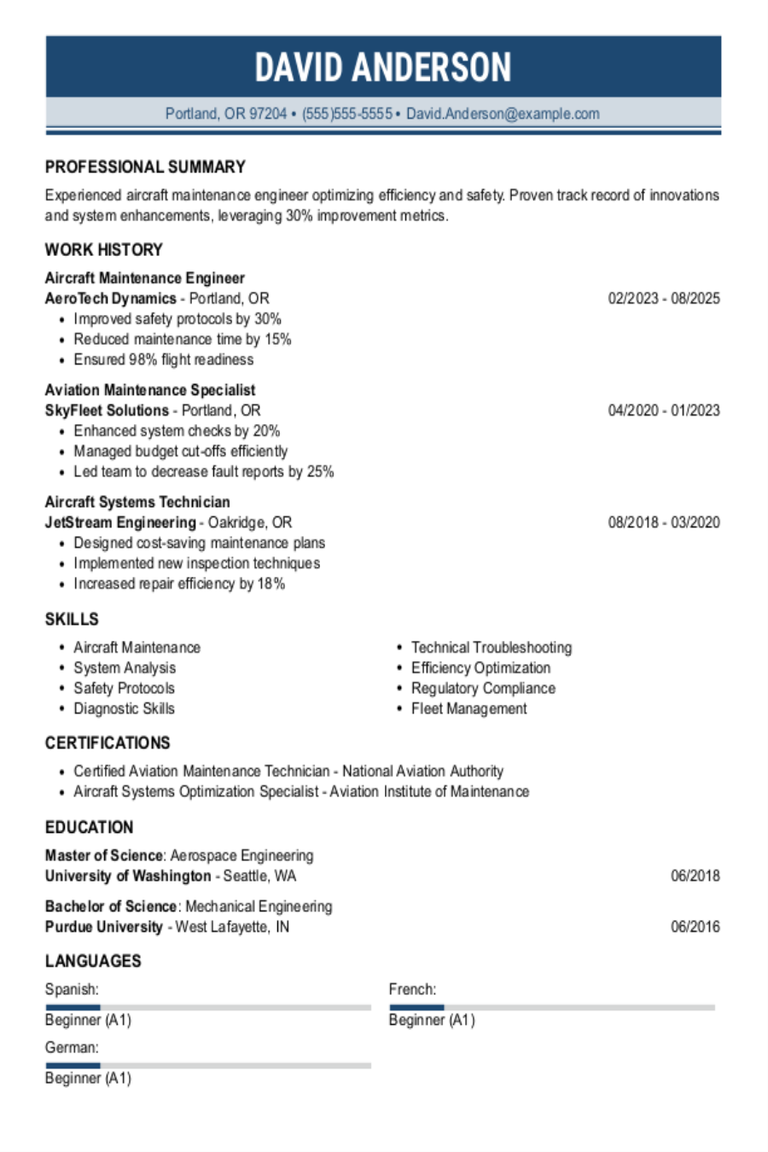
Aircraft Maintenance Engineer Resume Examples & Templates for 2025
Explore aircraft maintenance engineer resume examples that showcase skills in repairing and maintaining aircraft. These samples and tips can help you highlight your technical know-how and experience to stand out
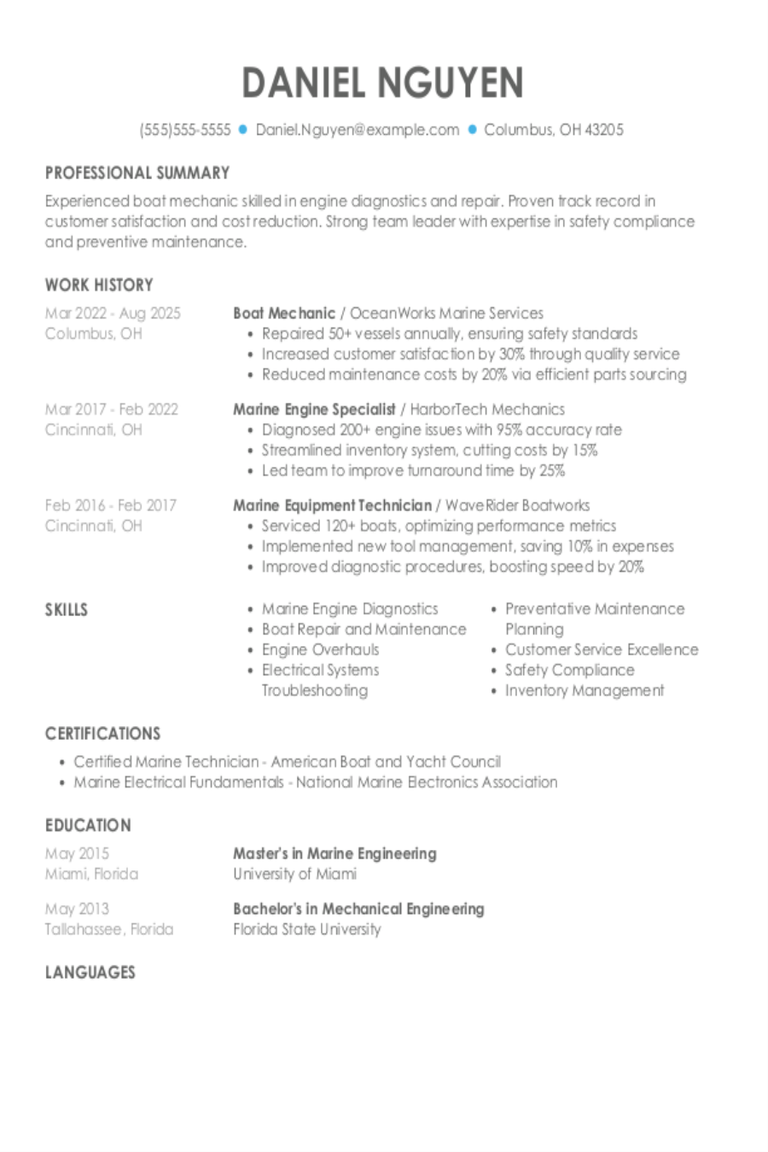
Boat Mechanic Resume Examples & Templates for 2025
Explore boat mechanic resume examples to see how to highlight experience fixing engines, diagnosing problems, and doing regular maintenance. Discover tips to showcase your skills in keeping boats running smoothly
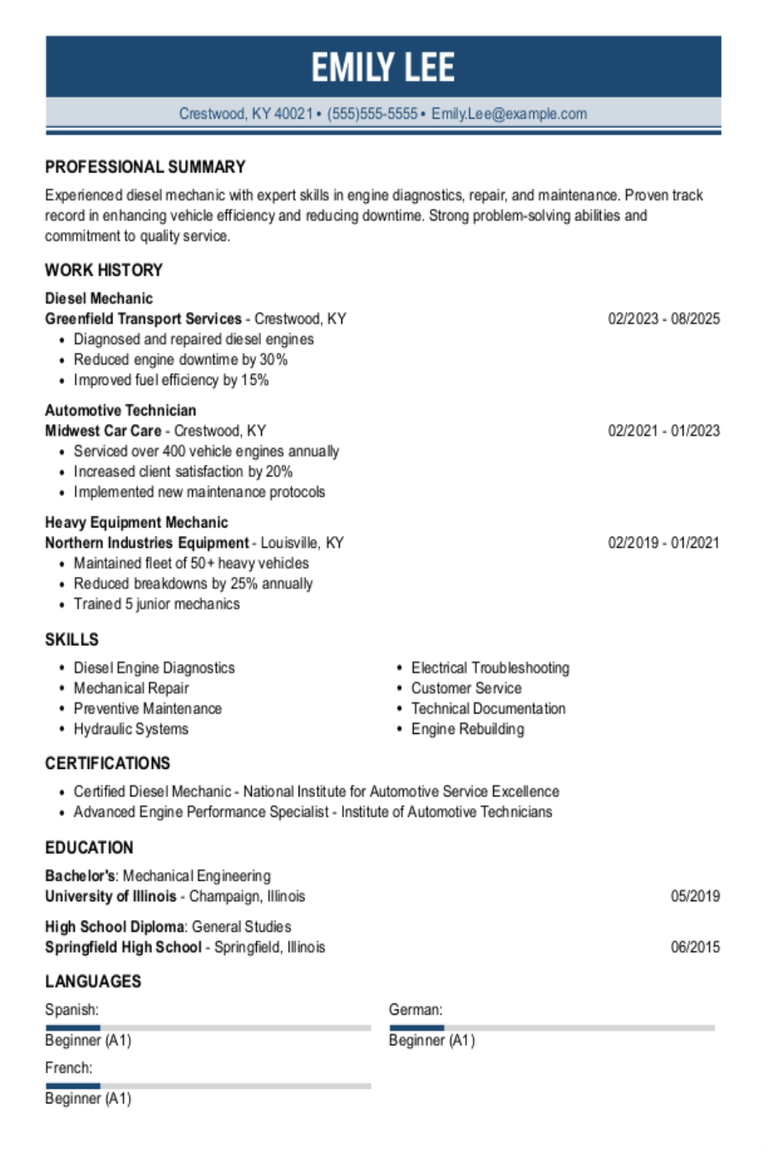
Diesel Mechanic Resume Examples & Templates for 2025
Explore diesel mechanic resume examples to see how to list repair skills and experience working with heavy equipment. Use these samples and tips to share hands-on experience that stands out
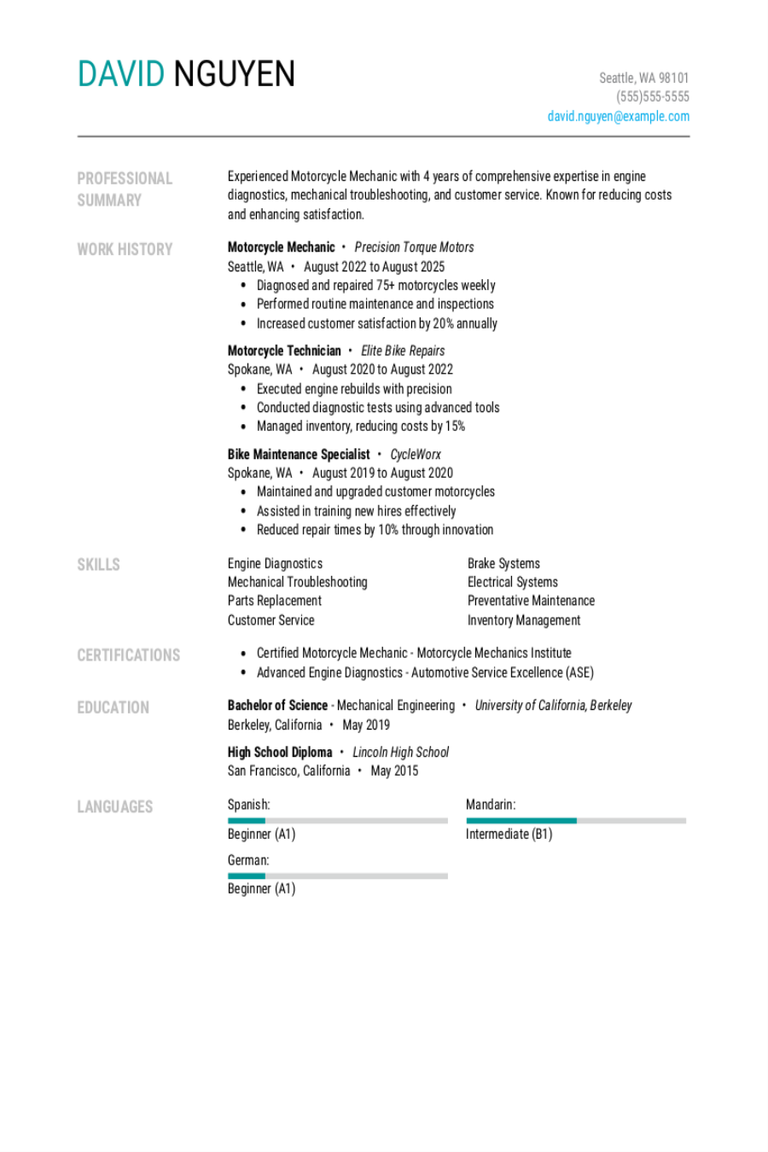
Motorcycle Mechanic Resume Examples & Templates for 2025
Discover how motorcycle mechanics can showcase their skills in fixing engines and maintaining bikes. These examples and tips will help you spotlight your hands-on experience and love for motorcycles to
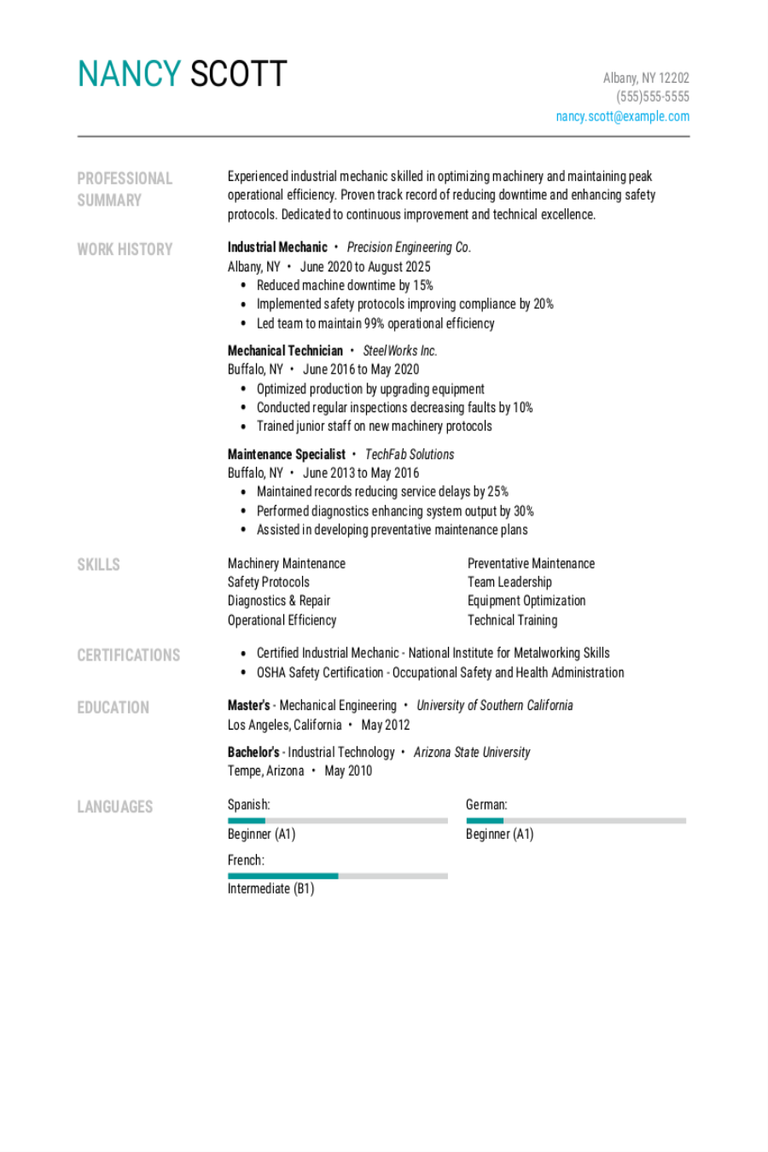
Industrial Mechanic Resume Examples & Templates for 2025
Explore how industrial mechanics highlight fixing machines and keeping equipment running smoothly on their resume. These examples and tips show you how to make your skills and experience shine on
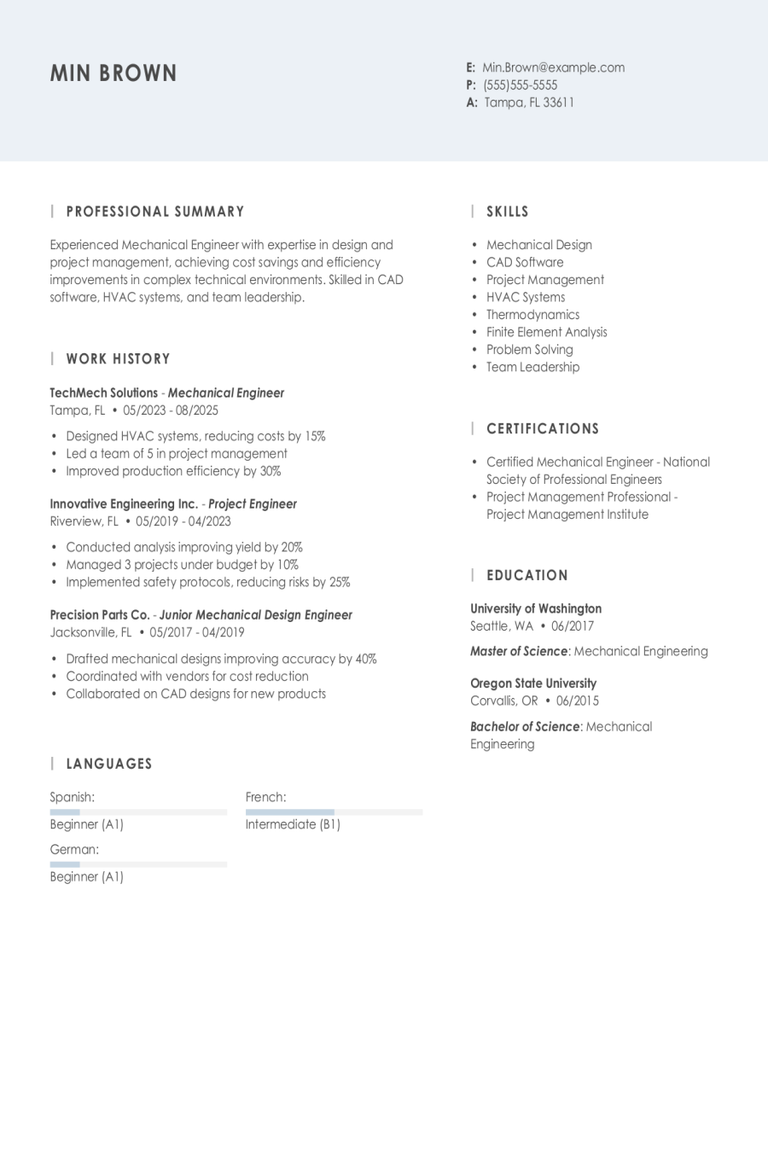
Mechanical Engineering Resume Examples & Templates for 2025
Explore mechanical engineering resume examples that show you how to highlight design skills, problem-solving abilities, and experience with machines. Learn to showcase your role in creating efficient systems and improving
